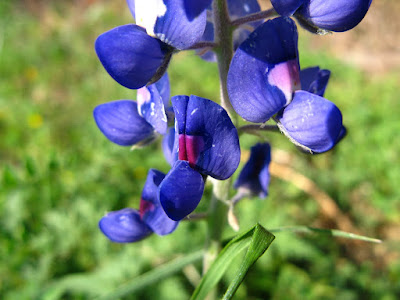 Last month I mentioned bluebonnets are the state flower of Texas:
Last month I mentioned bluebonnets are the state flower of Texas:The very first bluebonnet I photographed in my backyard this year was very young and none of the flowers on the spike had been pollinated yet. You can see my blog post about the "baby" bluebonnet, here.
How do I know if the blossom has been pollinated?
When the bees pollinate the bloom, the white section in the center of the little "bonnet shaped" flower turns a pinkish-red. My blogger friend, Hali, mentioned she'd like to see the color change and I promised a photograph so today it's time to deliver!
Here we go:
Bees don't interpret colors the same way humans see colors. They see the world in colors of blues, greens, and ultra-violet light. They can also see oranges and yellows. They can't see the color red.
Since bees can't detect the color red the flowers of the Bluebonnet have adapted to save energy and time for both the bees and the flower. The flowers want to be pollinated so they can produce a seed and continue the cycle of life. They bloom and present a pleasing flower of blue with a white (or yellow) center to attract pollinators. The bees can see the bloom no matter what the color, however, that center of white or yellow is the key attractant. As far as the bluebonnets are concerned, they want the bees to ignore a flower that has already been fertilized and move up to a flower on the spike with a white or yellow center (colors bees are attracted to and can "see").
In a nutshell, the reason the center of the bloom changes color is to encourage the pollinators to move to a flower on the bluebonnet spike that still needs pollination.
Since bees can't detect the color red the flowers of the Bluebonnet have adapted to save energy and time for both the bees and the flower. The flowers want to be pollinated so they can produce a seed and continue the cycle of life. They bloom and present a pleasing flower of blue with a white (or yellow) center to attract pollinators. The bees can see the bloom no matter what the color, however, that center of white or yellow is the key attractant. As far as the bluebonnets are concerned, they want the bees to ignore a flower that has already been fertilized and move up to a flower on the spike with a white or yellow center (colors bees are attracted to and can "see").
In a nutshell, the reason the center of the bloom changes color is to encourage the pollinators to move to a flower on the bluebonnet spike that still needs pollination.
The way bees and flowers work together is called symbiosis. Symbiosis is a relationship between two organisms of different kinds which benefits both organisms. Yay!
Go forth and bloom! :)
Go forth and bloom! :)



Wow, so interesting! Nature will never cease to amaze us.
ReplyDeleteThanks for visiting my blog .... I'm glad I followed you over to your blog and also to your shop ...beautiful work!
Hi Gina,
ReplyDeleteThank you!
Have a great weekend! :)